I have a friend who played St. Andrews last week.
The week before that he played Pebble Beach and Pine Valley.
I may even join him next week when he plans to play Augusta National.
You’re wondering how this friend of mine is able to play the top golf courses in the world?
Well, the fact is that he has access to all of these courses -- and dozens of others -- any time he wants to play them.
He’s one of the growing number of golfers who own a home golf simulator.
And with it, he can play anywhere, at any time of day or night, and in any weather conditions.
The Home Golf Simulator Boom...
Home golf simulators are increasing in popularity all over the world.
The National Golf Foundation (NGF) has estimated that there are about 4 million golf simulation participants in the United States alone, and there are millions of others across the globe.
Take South Korea as an example...
That small golf-crazed country has over 5 million golfers according to the Korea Golf Association, but they only have 545 golf courses.
With far more golfers than golf courses to accommodate them, playing on golf simulators has become something of a national pastime with 130,000 people a day playing virtual golf on a simulator.
Playing digital versions of real courses has become an obsession for these passionate golfers, and this may well be an indicator of what’s to come in many other countries as golf continues to get more and more popular around the world.

What’s a Home Golf Simulator?
A golf simulator is a set of equipment and software that allows you to play or practice golf on a graphically reproduced golf course or driving range.
From a hitting station, the golfer hits a real ball into a large screen that’s displaying realistic projected images of golf holes (on the more expensive units) or into a net (on the less expensive systems).
A computer then calculates the expected trajectory of the golf ball based on the data gathered on that swing, and the image of the golf ball’s flight is then simulated on the screen or on a computer display.
At that point, the computerized point of view shifts to what the golfer would see as he faces his next shot on that hole.
Simulators can range in complexity from fairly basic and inexpensive entry-level configurations (<$500) to extremely sophisticated and elaborate setups that can cost tens of thousands of dollars.
Most of the golf simulator packages come pre-loaded with a large number of famous golf courses.
From the golfer’s perspective, you’re simply enjoying a round of golf (minus the walking and fresh air!) and you’re hitting tee shots, iron shots, chips, and even putts the same as you would on an actual golf course.
It’s the technology that’s ‘under the covers’ of these systems, though, that allows you to enjoy this amazing virtual golf experience.
Depending on the level of complexity, they can include:
- Sound systems
- Optical sensors
- Radar
- Ball tracking systems
- Cameras
- And more
In addition to visually replicating the flight of the ball on these virtual golf courses, these systems can record and display data about your golf swing, such as clubhead speed, clubface angle and impact, club path, ball path, ball speed, horizontal and vertical launch angle, and spin.
So at the same time, you’re enjoying your round of golf, you can also be getting valuable swing data that you can use to improve your game.
Basically, golf simulators are designed to mimic real on-course golf experiences while improving your skills.
How Home Golf Simulators Work
The screen that the golfer hits into is connected to a computer that has sensors designed to calculate every aspect of the shot.
Usually, an array of light sensors, radar, and other motion tracking devices are placed around the border of the projection screen.
Once the ball strikes the screen, the information collected by the sensor array is sent to the computer which immediately analyzes a variety of factors from your shot, including ball speed, shot angle, distance, spin, trajectory, etc.
Golf simulators generally use one of three different tracking technologies in their systems:
They’ll either employ club tracking technology, ball tracking technology, or a combination of the two in what’s called a dual tracking system.
Club Tracking
In systems that use club tracking, the technology used is a set of infrared sensors contained in a floor-mounted device.
These simulators provide detailed information about your swing, such as:
a. Club path
b. Face angle
c. Clubhead speed.
Club tracking is usually found in the more affordable simulators, as manufacturers generally use lower-cost infrared sensors.
And although the benefit of club tracking systems is the relatively more friendly price point, they’re not quite as accurate as the more expensive ball trackers.
This is because club trackers measure the club movement but only estimate aspects of the ball flight, such as ball speed and launch angle.
Ball Tracking
Ball trackers, on the other hand, use radar or high-speed cameras to track the ball for its simulation.
These are highly accurate devices because they actually measure the ball, rather than simply estimating it as the club tracking devices do.
There’s a cost for this increased accuracy of ball-tracking simulators, though.
They’ll almost always be more expensive than club tracking simulators.
However, the downside is that they don’t provide the information about your club that a club tracker does.
Dual Tracking
Then, there’s the best of both worlds.
Dual tracking systems include both club tracking and ball tracking and include measurements from both in its simulation.
As you might expect, the high-end, premium golf simulators are primarily dual tracking systems and therefore are the most costly type of simulator.

Space Needed for a Home Golf Simulator
Typically, the best spot for setting up a simulator is the family room or the garage / basement.
In terms of space needs, you’ll need to take into consideration the room’s ceiling height, width, and depth.
a. Ceiling Height
9 or 10 feet is usually a sufficient height to safely accommodate most players’ swings.
It’d be possible to have a ceiling height of less than that if the primary user of the system is shorter than average in height, but even in that instance, you need to keep in mind that others may also occasionally use the simulator as well, and they may be taller.
If at all possible, seek out a space that has at least 9-10 feet or more and you should be okay.
b. Width
A safe guideline for width would be about 15 feet.
That may sound like a very wide space, but this recommendation takes into account the possibility that the user may occasionally hit a ‘wayward’ shot.
If the space isn’t wide enough, one of these foul balls could potentially hit a sidewall and that’s obviously something you’d prefer to avoid.
Another consideration would be if there’s a possibility that both right and left-handers will be using the system, with one obviously hitting from the left side of the mat and the other hitting on the right.
This would effectively expand the width requirement by several feet.
All things taken into account, 15 feet will usually be an adequate width.
c. Depth
The recommended depth of the room you’ll need is about 15 – 18 feet.
This includes approximately 6 feet from the back wall to the golfer, about 8-12 feet from the golfer’s hitting area to the screen, and another foot or two from the screen to the wall behind it.
Specific simulator models may call for additional depth due to the type of technology they use and the required placement of sensors.

Benefits of Home Golf Simulators
There are many benefits to owning a home golf simulator.
It’s no wonder they’re becoming so popular:
1. Golf Becomes Weatherproof
Because your simulated golf experience takes place indoors, you can play or practice regardless of the conditions outside.
Borrowing from the postal carrier’s motto, “Neither snow nor rain nor heat nor gloom of night stays these golfers from the swift completion of their appointed rounds.”
Apologies to all the postal carriers for that.
2. Limited Space Is Needed
As we described above, golf simulators can be placed in fairly limited spaces.
We’ve recommended what we feel are safe dimensions although, obviously, some home simulators are put in even more confined areas.
This allows you to set up your system in a garage, family room, or in any area that has sufficient room.
3. You Can Play Rounds or Just Practice Your Swing
The main selling point of golf simulators is the ability to play full 18-hole rounds of golf from the comfort of your home.
However, an additional benefit to these systems is that you can use them simply to practice and fine-tune your swing.
Most systems have the additional option to select a virtual driving range image instead of a golf course and you can then use your session on the simulator in place of a trip to the actual range.
Also, what better place to prepare for a real round of golf than by warming up on the golf simulator prior to your trip out to the course?
4. You Can Use Your Own Golf Clubs
If you’re playing a round of golf, even if it’s a virtual round, or if you’re practicing on a virtual driving range, you’ll get much more benefit and enjoyment by using your own golf clubs and real golf balls.
There’s no need to settle for unfamiliar rented equipment or fake golf balls.
5. Use for Instructional Assistance
As described above, golf simulators use either club-tracking or ball-tracking technology (or both) to provide you with data and statistics about your golf swing and about the flight of the ball.
The simulator sends this information to the computer to give you the ability to identify and analyze your swing and to identify possible swing flaws that need improvement.
6. Wide Range of Pricing to Suit Any Need
When choosing the home golf simulator that’ll be right for you, the decision often comes down to budget.
Fortunately, there are systems available at any price point, with the lower-end systems starting at just under $500, while the premium, high-end systems can cost tens of thousands of dollars.
And, depending on the amount of your budget and your appetite for bells and whistles, the top-end simulators can actually move into the six-figure range.
Conclusion
Having seen the growing popularity of home golf simulators, manufacturers have responded by introducing models at many different price points, making them accessible to every golfer who wants to get into the world of virtual golf.
Two initial things should guide your selection of the simulator that’d be best for you:
- The amount of money you’re willing to spend
- The available space that you have for a system
Once you know these two criteria, you can then shop and compare features to identify the home golf simulator that best meets your needs.
A golf simulator can be a considerable investment in both space and cost, but the technology can benefit all types of golfers.
Low handicap players and aspiring professionals can use simulators to monitor and improve their swing technique while more casual players can enjoy the opportunity to “play” on the world's most celebrated courses.
